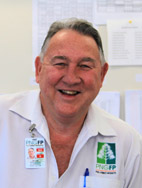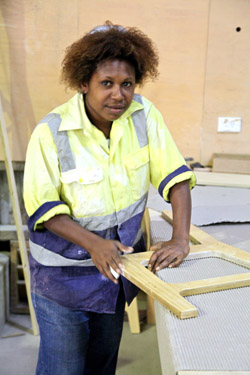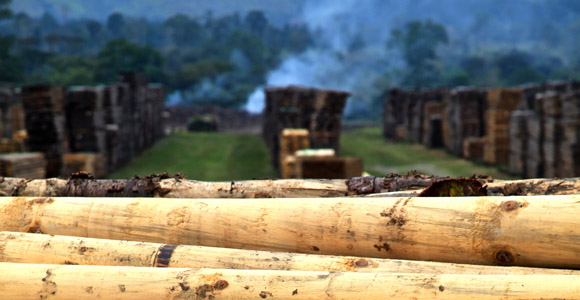Sustainability and value-adding are repeatedly stated as the goals for Papua New Guinea’s forestry sector. Ian Neubauer visits Bulolo in Morobe Province, an old gold-mining town that has re-invented itself with a sustainable timber industry.
In 1932, the Bulolo Gold Dredging Company airlifted a 110- tonne dredge piece by piece from the port city of Lae to the Bulolo River Valley.
The largest single part, the main tumbler shaft, was four-metres long and weighed more than three tonnes.
The operation pioneered large-scale air transport in PNG.
It also turned Bulolo, a tributary of the Markham River in Morobe Province, about 30 kilometres northwest of Wau, into the epicentre of gold production in the former Territory of New Guinea.
After the installation of seven other dredges flown in from Lae during the 1930s, gold production in Bulolo reached a peak of 8.5 tonnes in 1942. Production was interrupted during World War 2, when the Allies strafed Bulolo to prevent its infrastructure falling into Japanese hands under the scorched-earth policy.
Dredging resumed in 1946, with another 47 tonnes of gold removed from the river until reserves petered out in 1965.
When the dredges went silent in Bulolo, the timber industry took its place.

PNG Forest Products’ Ian Cobb. Credit: Ian Neubauer.
But unlike the controversial deforestation practices the World Wildlife Fund blames for the loss of biodiversity across some parts of PNG, Bulolo harvests hoop and klinki pine from a 100,000-hectare plantation that was seeded by the Gold Dredging Company in the 1930s to provide timber to build houses for its workers.
‘I’ve seen deforestation in parts of the country and I am not an advocate of that. Our timber supplies are 100 per cent sustainable,’ says Ian Cobb, the Australian-born General Manager of PNG Forest Products in Bulolo.
Self-sufficiency
PNG Forest Products’ operations in Bulolo are not only sustainable but self-sufficient as well.
During a recent tour of the mill with purchasing and logistics manager Kevin Fauth, Business Advantage PNG was shown in-house workshops for signwriting, auto mechanics, plumbing, overhead power lines, carpentry, research and development, engineering and more.
The mill even has a small cattle farm and abattoir that butchers thick T-bone steaks and succulent rib-eye medallions for the Bulolo Country Club, a licensed venue overlooking the Bulolo Golf Club – the oldest golf course in PNG.
‘We have all the trades covered here,’ says Fauth. ‘We even generate our own water and power.’
Power play
Until two years ago, PNG Forest Products produced a modest 5.5 megawatts of electricity from two hydroelectric stations—just enough to power the mill and homes of 1500 employees and their families who live in the bucolic gated community surrounding the mill.
The addition of a third hydroelectric station in 2013 upped power production to 14 megawatts – and created a new income stream for the company.
‘The third power station was built purely and deliberately as a commercial enterprise,’ Cobb says. ‘We have an agreement with PNG Power Limited to sell them the power and direct all of it back into the grid.
‘Hydroelectric is one opportunity that has never properly been exploited in this country, so I see us as a model to show the rest of the country how both forestry and power production can be executed sustainably.’
He adds: ‘We don’t rely on the government for too much—only to keep the road open between here and Lae.’
Adding value

A carpenter at PNG Forest Products in Bulolo. Credit: Ian Neubauer
PNG Forest Products can’t compete on price against the run-of-the-mill structural type plywoods produced cheaply in Indonesia. So it specialises in niche high-end plywood products instead.
Cobb says the company excels at marine-grade ply, form ply and all sorts of specialty ply treated with veneers and overlaid with products like coach floor and train floor. “It’s all about adding value,” he says.
Further value is added at PNG Forest Products’ voluminous factory floor, where carpenters, joiners and furniture makers – both male and female – manufacture a vast range of timber products for domestic consumption: everything from school desks, to coffins, bed frames, flat-pack kitchens, doors and kit homes to suit various budgets.
‘This is a house we are experimenting with in the Highlands,’ Fauth says, pointing out a small plywood roundhouse with a conical roof inset with a chimney. ‘You can knock it up or down in a day and you can even light a fire inside of it.’
Bridge to Australia
PNG Forest Products’ newest value-added item is a wooden bridge that’s seeing healthy demand in rural parts of the Australian state of New South Wales, with sales averaging one unit per month since the bridge was launched in 2014.
‘They are small bridges but that’s what we are all about,’ Cobb says. ‘We’re building another one right now in Tenterfield that’s 20-metres long and breaks down to nine sections. The installation time is minimal—once you have your abutments in place you can install one in a day or two.
‘That’s a big advantage for Australia, where the cost of labour is so high.’









Speak Your Mind